In Those Days, in Our Times
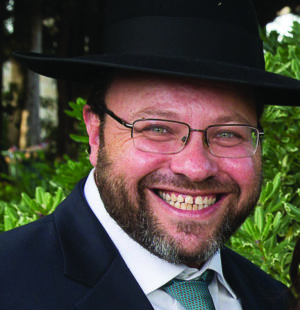
Rabbi Ephraim Schwartz revisits the sites of ancient battles and triumphs

Photos: Menachem Kalish
Miraculous battles didn’t start or end with the Maccabees — Hashem has been fighting our wars from the time Yehoshua led the nation into the Holy Land until today. As we retrace the ancient trails where some of the most famous battles took place, we’ll say Al Hanissim just a bit more fervently — because the miracles are still happening
IN
Eretz Yisrael, Chanukah’s actually been in the air since the beginning of Cheshvan, when for some reason the bakeries already begin to sell doughnuts. And once the shops begin to fill up with the sales on oil, wicks and menorahs, we really start to feel it, especially as the little gold glass boxes begin to appear outside of homes in anticipation of this special holiday. Perhaps the Chanukah spirit is so all-pervasive here, as it’s the only Jewish holiday where the backdrop took place in Eretz Yisrael, as opposed to all of the others that commemorate events outside the Land. And what better way to celebrate than a tour that will bring to life the wars and miracles that took place bayamim haheim bazeman hazeh.
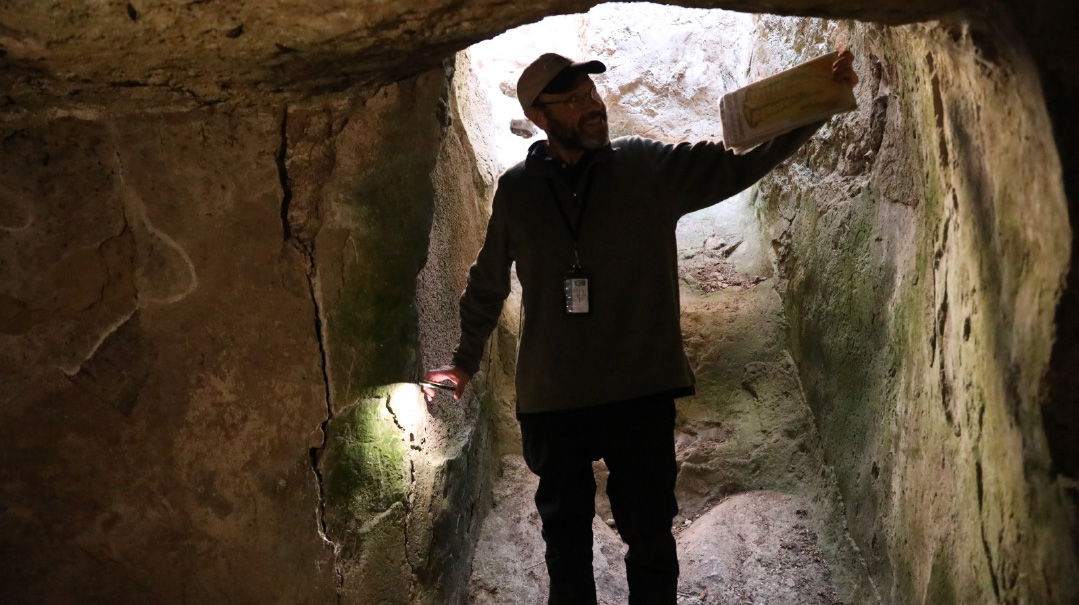
Although the ancient city was leveled, the huge, complex underground water system built by Shlomo Hamelech is still intact and safe enough for us to climb through
From Strength to Strength
Our tour today begins right outside one of the fastest growing cities in Eretz Yisrael, a place that many cynically refer to as mini-America due to the influx of tens of thousands of Anglo olim: the burgeoning city of Beit Shemesh. If you thought there’s another place where that famous tour guide joke about the national bird of Israel being the “crane” is more applicable, the huge construction projects on every surrounding hilltop — with original and creative names like Ramat Beit Shemesh Gimmel 1 and Gimmel 2, Daled 1-5, and Hei 1 and 2 — will change your mind. With over 150,000 residents and a growth rate of about seven percent per year, it’s the fastest growing city in the last decade, and many speculate it’s just getting started.
But our tour is not in the modern city of Beit Shemesh, but the ancient city upon which it is built. We’ll head out to the newly expanded Highway 38 that cuts right through the ancient city, and go back about 2,900 years to the original Jewish town.
Climbing up the ancient tel, we come across the walls of the former strategic city from where we have an incredible view of the border between the portions of the Tribes of Yehudah and Dan. To the west of us is the coastline, which was in ancient times the stronghold of the Pelishtim. The five coastal Philistine cities of Gat, Ashdod, Ashkelon, Aza and Ekron were constantly attacking the Jewish residents in these parts.
Not far from here to our east, along this highway, are the modern hamlets of Tzorah and Eshtaol, built near the remains of the ancient cities of the same names where Shimshon HaGibor dwelled and from where he would come down and fight against Pelishtim — terrorizing them and giving them back a taste of their own medicine. In fact, an ancient seal was found here at the tel with an embossed image of a man with long hair fighting off a beast. Yet after Shimshon’s passing, the Philistine threat forced the Tribe of Dan — whose parcel of land abutted their territory — to leave, and so they moved up north to the area of Tel Dan, on the border of the Golan Heights.
Below this tel are sprawling wheatfields, and it’s in these very fields — or perhaps their progenitors — where the Jews got the surprise of their life. Sefer Shmuel tells us that after the Pelishtim had captured the aron habris and killed Eli Hakohein’s sons, the aron caused so much damage within the Pelishti strongholds that they finally decided to send it back. Not wanting to fully admit that it was Hashem who was plaguing them, yet realizing it was a strong possibility, their priests and diviners chose to hedge their idolatrous bets and sent the aron up this road from Ekron on a wagon being pulled by two nursing cows. The natural tendency of cows is to come back to their calves and not leave them, and furthermore, these were cows that had never pulled a yoke, who would be unlikely to shlep the aron the distance. Yet the cows kept pulling the wagon all the way to these fields. The Jews who were working their farms looked up and lo and behold, the aron had returned. They sang, they rejoiced, and they brought offerings to Hashem.
Their simchah was short-lived, however. It seems that in the process they didn’t treat the aron with the proper respect and a plague broke out in the Jewish city as well. The pasuk (Shmuel I 6:19) tells us cryptically, “And Hashem smote in the nation 70 men, 50,000 men.” Those two radically different casualty numbers are debated by Chazal: One opinion is that it was the 70 zekeinim (elders) who were equal to 50,000 regular citizens, and others suggest that in fact 50,000 were killed and each was on the level of the 70 zekeinim. The aron was then taken from Beit Shemesh and brought to Kiryat Yearim (the modern day Telshe Stone) where it waited for 20 years until David HaMelech brought it to Yerushalayim.
As we walk down the tel, we note a huge, ancient underground water system that would preserve the rain water that fell into the streets of the city, supplying water for thousands of people. The system dates to the times of Shlomo Hamelech a century later, who built the city up and brought it to new heights. Ultimately, though, Beit Shemesh was first leveled by the Assyrian king Sancheirev when he conquered the Northern Kingdom, and then routed again by Nevuchadnetzar during the Churban of the first Beis Hamikdash. Hundreds of years later, during the period of the Second Beis Hamikdash, the Tanna Rabi Yochanan describes Beit Shemesh as being the smallest and most dilapidated of all the cities in Yehudah. If only he could see it today.
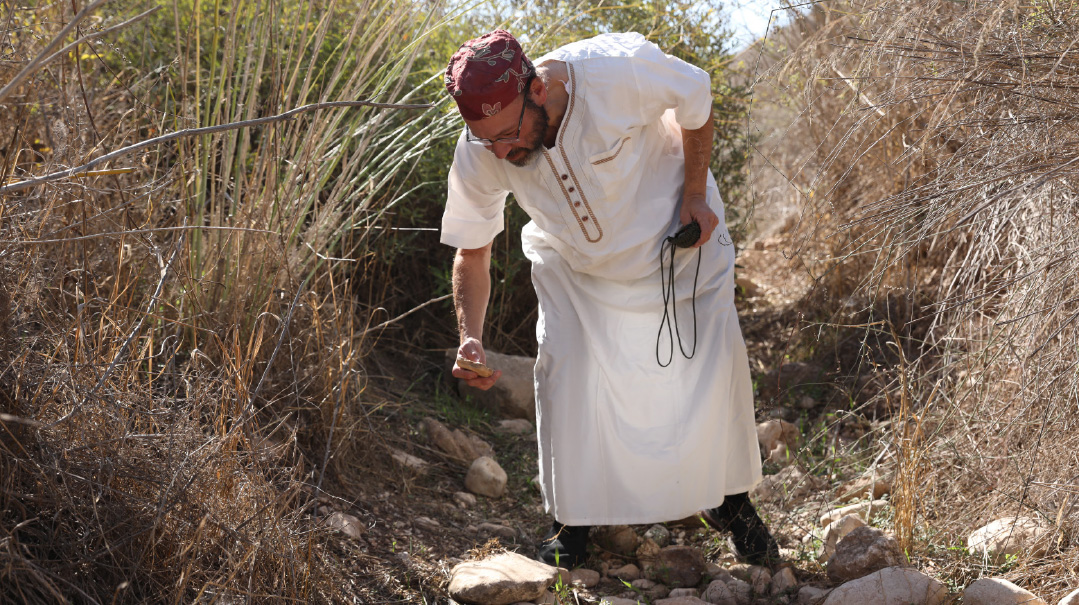
Rock of Ages
Driving up Highway 38 in the direction of the Pelishti coastline, we pass the sprawling Elah valley that lies between the two hills of Azeka and Socho. There is another name given for this valley though. It is the valley of Efes Damim — “No Blood.” To understand why the valley has this strange name, we open up to I Shmuel 17 and read the famous story of the great Pelishti army, led by the giant Goliyas, that gathered here against the army of King Shaul. Goliyas throws down the gauntlet and demands the Jews send out someone to fight him. There’s no need for there to be blood spilled here, just a one-on-one against Goliyas — and the losing team would be slaves to the victor.
The pasuk tells us that “the Philistines stood on the mountain from this side and Yisrael stood on the hill from this side and the valley was between them.” Looking out from our vantage point on the bridge of the Elah riverbed, it doesn’t get more real than that — until my good friend Tzvi Weiser of Tanach Warriors shows up. (Tanach Warriors is a very cool program of adventure and fun for the whole family, testing your prowess in archery, slingshot weaponry, and other battle motifs.) Tzvi has brought with him all of the paraphernalia to really bring this piece to life. A native Brooklyner and a lifelong history and Tanach buff, Tzvi — whose daughter is a tour guide — was drawn into this side business of his by his desire to bring the stories of our history to life for tourists, groups, and families living here. Over the years he’s built up a collection of ancient weapons and uniforms from different eras, and he runs programs and activities at the sites where the battles took place.
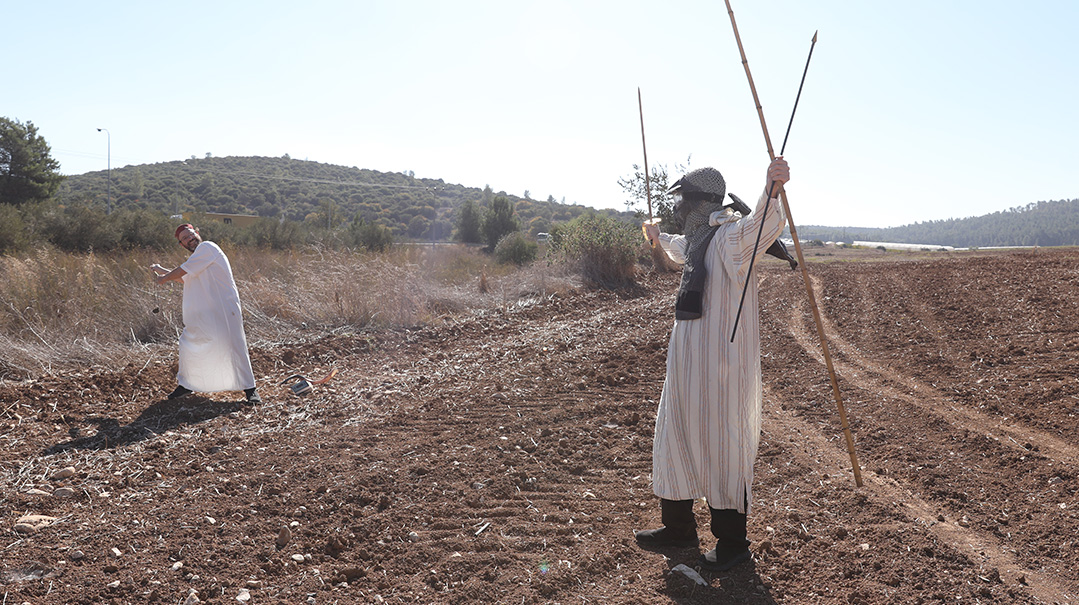
In the Elah Valley between the two hills of Azeka and Socho, together with my friend Tzvi Weiser, the battle of David and Goliyas doesn’t get more real than this. Down to the riverbed for pebbles, a slingshot against a sword, and a holy victory (Tzvi was a good sport)
With Tzvi’s help, I get into the Dovid Hamelech costume while he puts on the Goliyas armor. I head down to the riverbed to pick up five smooth stones and place them in my slingshot to throw at him. Almost like Dovid trying to put on a much larger Shaul’s armor, I first tried to put on the armor Tzvi brought, but being the new slim Ephraim Schwartz, it kept falling off. Baruch Hashem, I’m not that great of a shot and Tzvi walks away fine from our duel, unlike the real Goliyas, whom Dovid hits right in the helmet and whose head he chops off before chasing after the Philistines.
There is a fascinating midrash that describes one of the many miracles that took place on that day. The midrash says that when Dovid’s little rock hit the helmet of Goliyas, the helmet didn’t want to open to let the rock in to kill him. The rock then offers the helmet the mitzvos it had accrued of bris milah, which had until that point been done with a flint rock, in exchange for opening up to allow it to kill Goliyas. And thus for all times, the mitzvah of bris milah is done with a metal knife.
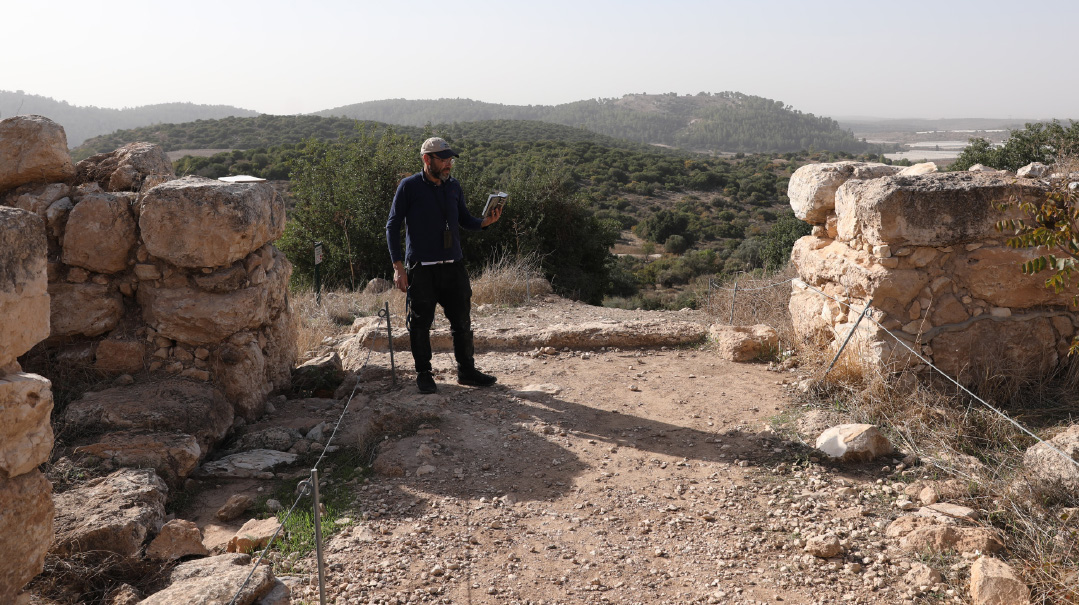
Shaarayim, a fortified city of “two gates” that have stood the test of time, was proof that such Jewish cities existed during Dovid Hamelech’s rule
Out of the Starting Gate
Where did the Pelishtim flee from here? The verse tells us that they fled out of the valley toward the coastal cities of Gat, and their corpses lined the road until the city of Shaarayim. Sure enough, not far from here we see in the distance a towering hill that is today known as Tel Keyafah, which has been identified as the ancient city of Shaarayim — so naturally, we make our way over to explore this important Tanach site.
Tel Keyafah was already recognized as an important site by the pilgrims and biblical archeologists in the mid-19th century, yet it wasn’t until about 15 years ago that it was finally identified as Shaarayim by a crowning piece of evidence, which strengthened the side of Torah in one of the greatest archeological debates in Israel. Many archeologists have consistently denied the authenticity of the kingdoms of Dovid and Shlomo, claiming there was no organized Jewish presence in the Land and no fortified Jewish cities, preferring to consider these great kings as small village chieftains at best. This school of thought maintained that there were no significant Jewish finds from those eras, and it wasn’t until the times of Achav a century or so later that Malchus Yisrael really became expanded — and even if there was a Dovid and Shlomo, the most they had were small tribal portions just around Yerushalyim.
All that changed when archeologist Yossi Garfinkel discovered a huge walled city here, with two remarkably large gates — the largest in Eretz Yisrael, with rocks weighing over ten tons that spanned 2,300 feet around the six-acre city, dating back to the period of the reign of Shaul and Dovid. There is no other city from this time period that has two gates, and it would therefore explain why the city was called Shaarayim (“gates” in plural). Garfinkel dismissed the possibility that this was a Philistine or Caananite city, noting that the town plan was characteristic of other excavated Jewish towns, such as ancient Beit Shemesh.
Also discovered were inscriptions in ancient Hebrew script with the name of one of Dovid Hamelech’s generals. These discoveries were the slingshot that Garfinkel needed to knock down the heretical archeologists who had denied that Malchus Dovid extended this far. It seems like Dovid’s fight for the honor of Hashem didn’t end with Goliyas — his legacy is still fighting.
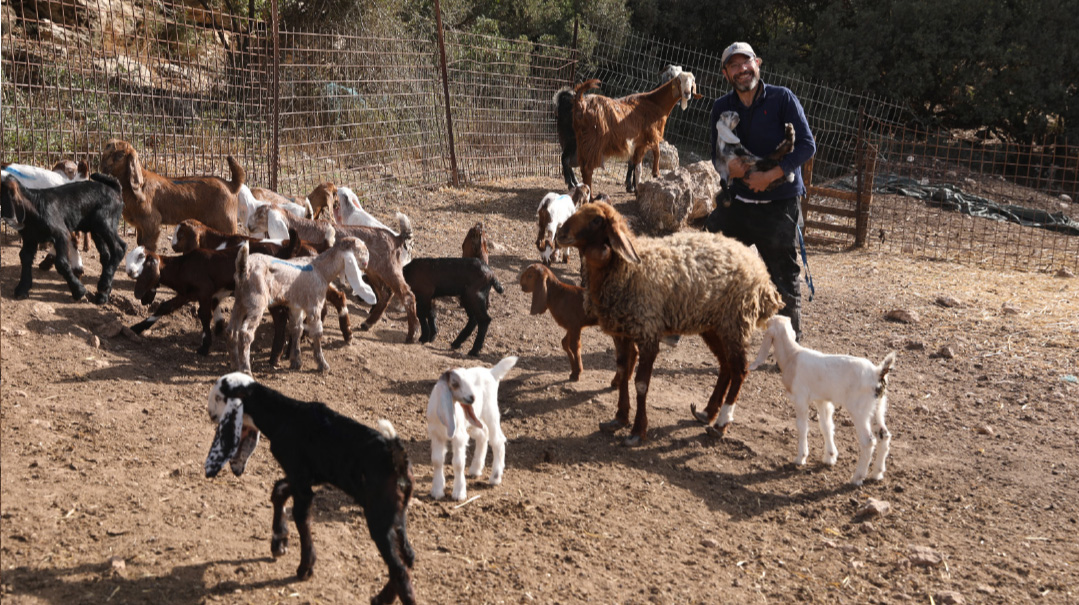
Nearly 4,000 years later, the goats are still in Adulam
Ready for Revolt
Traveling east, we head over to the large 50,000-Dunam archeological Park Adulam of the JNF. If the name rings a bell, it’s because this is the place that Yehudah goes down to from Shechem after the sale of Yosef. Here is where his friend, Chirah is from and where he meets his wife Shua and has his three sons. As we know, a significant part of that story is when he seeks out his daughter-in-law Tamar to give her the goats he had promised her. He couldn’t find her, but we figured we’d at least seek out some goats. After a bit of a drive around these ancient hills, we find ourselves in a little Bedouin camp that has lots of goats for us to chase and hold.
One of the most striking things about this nachalah of Shevet Yehudah are the many remains of towns and tunnels that have been uncovered on these hills. These ruins of Churbat Etri, a former city from the times of the Second Beis Hamikdash, are certainly Jewish ones. We pass an immense winepress that was quarried out of the rock, and right away we think of the connection to Shevet Yehudah’s blessing of wine that is so plentiful they can wash their clothing in it. Looking down at the vineyards around us, we see the land that was desolate for thousands of years while we were not here once again flourishing with that brachah.
In the archeological digs that were done here they discovered a beis knesses, quite a few mikvaos, and uncovered a layer of ashes filled with bones, including a skeleton of a decapitated neck. The mystery of that poor fellow became clear as researchers discovered a whole network of hidden underground tunnels that led from building to building and out of the city. These tunnels date to about 60 years after the Churban, when the army of Bar Kochva led a three-year revolt against the Romans. Many coins minted at that time inscribed with the words “For the Redemption of Yerushalayim” were found here, and testify to the idealism of this army of the students of Rabi Akiva, who initially inspired the revolt and saw this era as being ripe for the Redemption.
In the past, I was never tempted to try to climb into these tunnels, yet feeling skinnier, I thought I’d give it a go. But many of them were closed and falling apart, so I passed and instead headed over to the next tel, called Churbat Burgin. Archeologists have identified this village with a city during the times of the revolt against the Romans called Kfar Bish (“City of Shame”). It got its name and suffered its fate because the residents didn’t welcome guests into their homes. According to Josephus, when Vespasian came to put down the Jewish revolt that led up to the Churban, the city surrendered to him and was destroyed. It was reestablished afterward and used as a base from where the armies of Bar Kochva would attack the Romans.
My friend Tzvi has brought some ancient Roman armor, and I imagine Roman troops lying in wait in the surrounding hills that I am preparing to attack, in order to liberate Yerushalayim under “Mashiach’s army” of Bar Kochva. The inspiration of Rabi Akiva, who saw this era — the beginning of the final 2,000 years of Creation — as yemos haMashiach, pushes me to face the overwhelming odds.
Perhaps the time was ripe, but the revolution failed, the Har Habayis was plowed under, and the Sanhedrin moved north, which became the new center of Eretz Yisrael for the next 1,700 years. Bar Kochva turned out to be Bar Koziva — the false leader who fell prey to his own imagined strength and forgot Who is the real Force behind the armies of Israel.
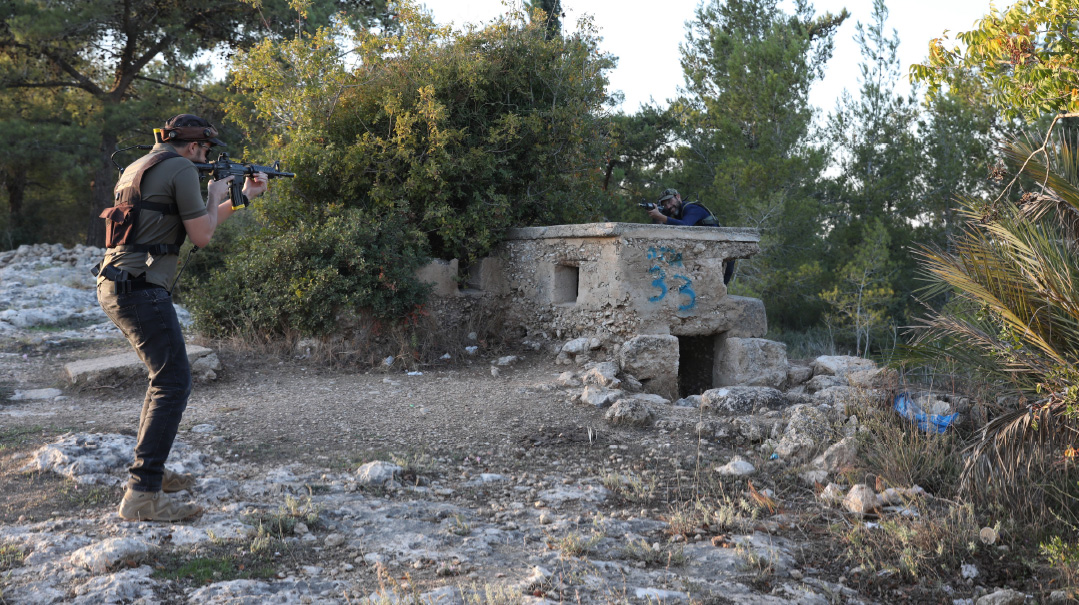
From Yehoshua to the Maccabees and beyond, the Ayalon Valley was a place of liberation from the oppressor. Looking down over the valley, Mendy from Falcon Laser Tag shows us how two millenia later, Israeli soldiers shot through the bunkers that still remain here from the Jordanian Legion posts
When the Sun Stood Still
I’ve been having too much fun with this dress-up tour to give it up now, so for the next stop I’ve contacted another friend of mine, Mendy from Falcon Laser Tag, to meet us at Park Canada on the strategic hills overlooking the Ayalon Valley. I generally won’t take tourists to amusement parks or Laser Tag or Paintball, all of which they can get in the States, but nowhere else can you get into gear and train just like real Israeli commando soldiers who utilize Falcon’s MP4 laser guns for their army exercises, overlooking the valley where some of the most important battles of our ancestors took place. Running in full army gear and shooting through the bunkers that remain here from Jordanian posts in 1948, I feel myself turning into a soldier.
It’s here in the Ayalon Valley where upon coming to Eretz Yisrael, Yehoshua waged war against the five Canaanite-Emorite kings. It was a battle he was brought into under false pretenses when the Givonim, who passed themselves off as coming from afar, elicited an agreement from Yehoshua that the Jews would defend them. Although their ruse was discovered, Yehoshua abided by the agreement once they committed to converting and becoming the woodchoppers and watercarriers of Israel.
Little did he know how soon that chip would have to be cashed. The five kings gathered against the Givonim, and Yehoshua brought his army — miraculously with kefitzas haderech — all the way from Gilgal to fight against them. Hashem crashed down hailstones upon the enemy, yet the sun was setting, it was Erev Shabbos, and that battle was not yet won. So, in a miracle that Chazal tell us was even greater than Moshe’s miracles, Yehoshua stopped the sun in the sky, and the moon stood still as he uttered the famous words, “Shemesh b’Givon dom v’yarai’ach b’emek Ayalon.” He wanted it to be clear to the enemy that Klal Yisrael had the power of Hashem behind them and were a force that couldn’t and wouldn’t be stopped. And thus, he wiped out the enemy without even one Jew falling.
Fast forward about 1,100 years, and in the period of the Second Beis Hamikdash, it is in this valley again where the Jews are up against a brutal enemy. It was the period of the Chashmonaim, the revolt against the Syrian Greeks and their decrees against our nation had begun, and we had already won two battles. The army of Yehudah Maccabee had begun to attract more and more recruits, so Antiochus pulled out his big guns, sending in his generals Nicanor and Gorgias and an army of tens of thousands of soldiers and chariots (the ancient equivalent of a tank) against the few thousand in the army of Yehudah. They gathered here in this valley.
Gorgias, knowing that the Jews were hiding up in hills, left a large force in the area to attack them, but Yehudah sneaked through the night and launched a pre-emptive surprise attack on the remaining Greek forces in the valley. By the time Gorgias returned, he saw his camp in flames and his soldiers fleeing. This caused his own men to lose heart and flee, chased away by Yehudah’s ragtag army. The battle was won, and more and more Jews joined the Maccabee forces. The next battle a few months later would lead to the liberation of the Beis Hamikdash, the miracle of the flask of oil and the purification and return of the service to Jewish hands.
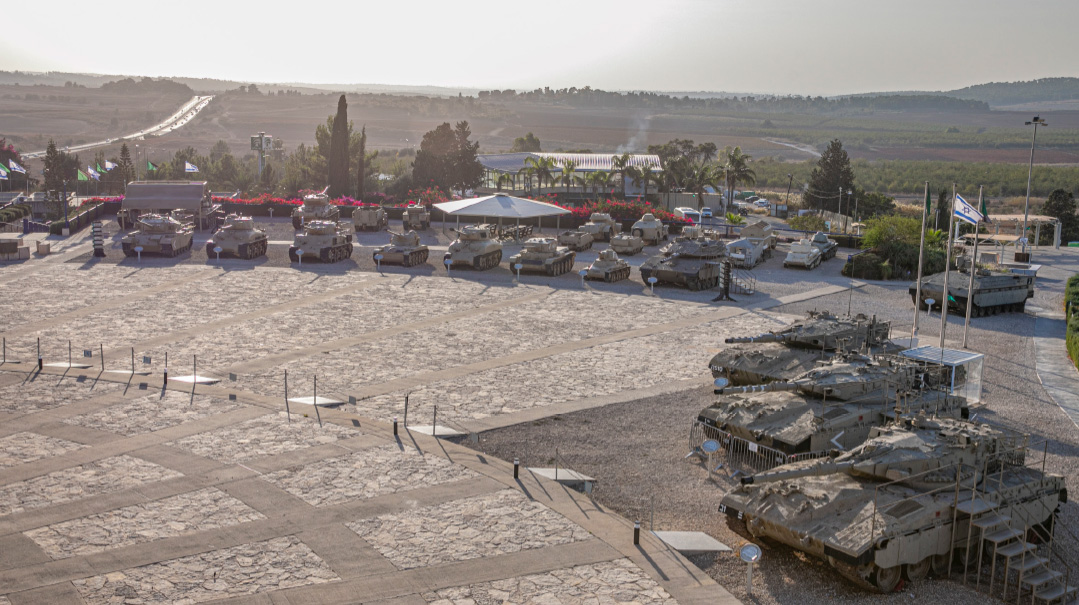
One with the Miracles
From Park Canada we drive five minutes up the road to Latrun, the home of Israel’s Armored Corps memorial site, which, with over 160 tanks and armored vehicles from all over the world that were used in Israel’s wars, is one of the world’s largest tank collections. This former Crusader castle had once been a French monastery, and was used by the British as a detention camp during World War II. By 1948, during Israel’s War of Independence, the British were long gone, but this hilltop, which overlooks the only road that went from Tel Aviv to Yerushalayim, was of strategic significance, for that road was the only way to bring food, supplies and ammunition into the city that was under siege by the Arab Legion. Armored vehicles that attempted to bring supplies in were shot down by the Arabs from the hills above, and hundreds of Jewish fighters — many of them teenaged Holocaust survivors who had managed to get themselves to Eretz Yisrael — gave their lives on these perilous roads.
Although the capture of Latrun failed, the Israeli army, under the leadership of General Mickey Marcus (an American), was able to pave a road through the mountains, known as the Burma Road, and bring supplies and relief to the besieged Jews in the Holy City — although it would be another 19 years until the Old City was liberated and Latrun finally captured as the Arab legions fled the hilltop.
As we walk through the memorial halls and the Tower of Tears for the 5,019 fallen soldiers of the armored brigades, we head to the adjacent shul to recite Tehillim l’illui nishmasam.
Leaving Latrun, I find myself humming Al Hanissim with greater appreciation. I think of the miracles of Yehoshua and the Maccabees, the return of the ancient aron habris, the gevuros of Shimshon and David, the well-intended soldiers of Bar Kochva and the yeshuos and nechamos that Hashem has given us throughout the generations. When we light Chanukah candles, the seforim tell us, we are not merely commemorating the miracle, rather we become like the Kohein Gadol lighting the menorah in the Beis Hamikdash. And then, it’s not just a dress-up in the costume of the day. Our national memory connects with those periods, and we become one with the miracles and mesirus nefesh of the past. May this Chanukah herald in that final era when not only will we see the candles burning in all the chatzros kodshecha as they are today, but also with the Kohein Gadol himself in the eternal Beis Hamikdash.
(Originally featured in Mishpacha, Issue 940)
Oops! We could not locate your form.







